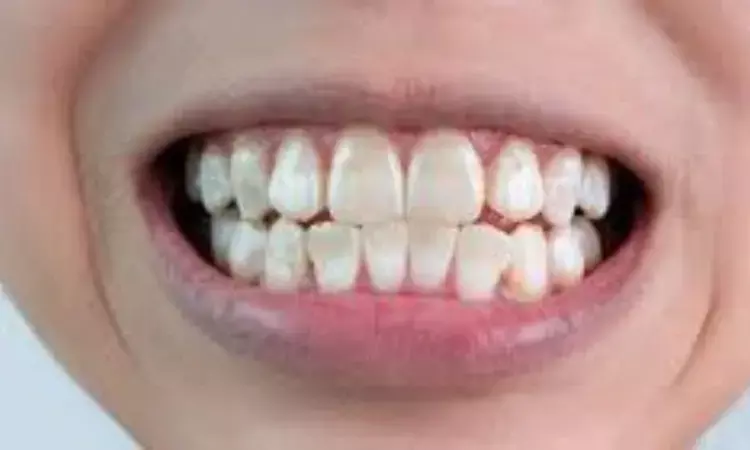- Home
- Medical news & Guidelines
- Anesthesiology
- Cardiology and CTVS
- Critical Care
- Dentistry
- Dermatology
- Diabetes and Endocrinology
- ENT
- Gastroenterology
- Medicine
- Nephrology
- Neurology
- Obstretics-Gynaecology
- Oncology
- Ophthalmology
- Orthopaedics
- Pediatrics-Neonatology
- Psychiatry
- Pulmonology
- Radiology
- Surgery
- Urology
- Laboratory Medicine
- Diet
- Nursing
- Paramedical
- Physiotherapy
- Health news
- Fact Check
- Bone Health Fact Check
- Brain Health Fact Check
- Cancer Related Fact Check
- Child Care Fact Check
- Dental and oral health fact check
- Diabetes and metabolic health fact check
- Diet and Nutrition Fact Check
- Eye and ENT Care Fact Check
- Fitness fact check
- Gut health fact check
- Heart health fact check
- Kidney health fact check
- Medical education fact check
- Men's health fact check
- Respiratory fact check
- Skin and hair care fact check
- Vaccine and Immunization fact check
- Women's health fact check
- AYUSH
- State News
- Andaman and Nicobar Islands
- Andhra Pradesh
- Arunachal Pradesh
- Assam
- Bihar
- Chandigarh
- Chattisgarh
- Dadra and Nagar Haveli
- Daman and Diu
- Delhi
- Goa
- Gujarat
- Haryana
- Himachal Pradesh
- Jammu & Kashmir
- Jharkhand
- Karnataka
- Kerala
- Ladakh
- Lakshadweep
- Madhya Pradesh
- Maharashtra
- Manipur
- Meghalaya
- Mizoram
- Nagaland
- Odisha
- Puducherry
- Punjab
- Rajasthan
- Sikkim
- Tamil Nadu
- Telangana
- Tripura
- Uttar Pradesh
- Uttrakhand
- West Bengal
- Medical Education
- Industry
Dehydration affects shade of teeth and may look them whiter

Lebanon: A prospective in vivo study published in Cureus has shed light on the effect of dehydration on tooth colour.
The researchers showed that dehydration impacted the teeth's shade: lightness increased, and therefore, the teeth appeared whiter.
"Dentists should consider the teeth's hydration status when evaluating colour for treatments, as there is a significant impact of dehydration on shade matching: the more the dehydration time elapses, there is more increase in the colour difference compared to the baseline," the researchers wrote.
In dentistry, the teeth's shade is an essential factor that determines the aesthetics, and the patient's satisfaction. Therefore, shade matching is a crucial step that reflects the success of the aesthetic restoration outcome. According to several technicians and dentists, this step represents the major challenge. Thus, particular importance must be given to it.
The impact of dehydration on tooth shade constitutes a significant, making it an important area of study, specifically within the field of restorative dentistry. Céline Alamé and Carina Mehanna Zogheib from Saint Joseph University in Beirut, LBN, and colleagues aimed to evaluate the effect of dehydration on the shade of the teeth using a spectrophotometer in a prospective study.
The following null hypotheses were tested: (1) The shade of the teeth does not vary according to their hydration degree, and (2) the ability of shade matching could be conducted at any given time.
For this purpose, the researchers recruited twenty-five participants; the study was conducted between October 2022 and January 2023. The study's inclusion criteria primarily comprised four intact maxillary incisors. Cavities, damage, restorations, and staining served as exclusion criteria.
The measurements were recorded using the VITA Easyshade Advance spectrophotometer. The measures of L (representing darkness to lightness), a (representing greenness to redness), and b (representing blueness to yellowness) were registered at the centre of each tooth's labial surface at baseline and then at 10-minute intervals for 30 minutes while the teeth were dehydrating due to rubber dam placement.
Calculation of the colour difference (ΔE) was done using L*a*b* measures, with the perceptibility threshold set at ΔE00=0.8. Statistical analyses were performed using the Bonferroni post hoc test, the Friedman test, and the Wilcoxon signed-rank test.
The study led to the following findings:
· The different colour changes represented by ΔE (ΔE1, ΔE2, and ΔE3) were significantly higher than the perceptibility threshold of 0.8.
· A statistically significant difference was found between ΔE1 and ΔE3.
· A statistically significant difference was found between L0, L10, L20, and L30.
· Statistically significant differences exist between the means of L0 and L20, the means of L0 and L30, the means of L10 and L20, and the means of L10 and L30.
The study concluded that there is a significant impact of teeth dehydration on teeth shade, particularly affecting the perception of whiteness. The dehydration time duration directly corresponds to the extent of colour difference from the baseline. This strongly refutes the initial hypotheses, asserting that teeth shade remains constant irrespective of hydration status and that shade matching can be indiscriminately performed at any time during a dental procedure.
"These findings emphasize the importance of carrying out shade matching before any procedure leading to teeth dehydration, such as rubber dam isolation," the researchers wrote. "We hope that these insights will guide dental practitioners in augmenting their shade-matching practices, ultimately improving patient satisfaction."
"Further research would be needed that might focus on identifying ways to reduce the impact of hydration on colour change or developing more adaptive shade-matching techniques that account for teeth hydration levels," they concluded.
Reference:
Alamé C, Mehanna Zogheib C (November 02, 2023) The Effect of Dehydration on Tooth Color: A Prospective In Vivo Study. Cureus 15(11): e48140. doi:10.7759/cureus.48140
Dr Kamal Kant Kohli-MBBS, DTCD- a chest specialist with more than 30 years of practice and a flair for writing clinical articles, Dr Kamal Kant Kohli joined Medical Dialogues as a Chief Editor of Medical News. Besides writing articles, as an editor, he proofreads and verifies all the medical content published on Medical Dialogues including those coming from journals, studies,medical conferences,guidelines etc. Email: drkohli@medicaldialogues.in. Contact no. 011-43720751


